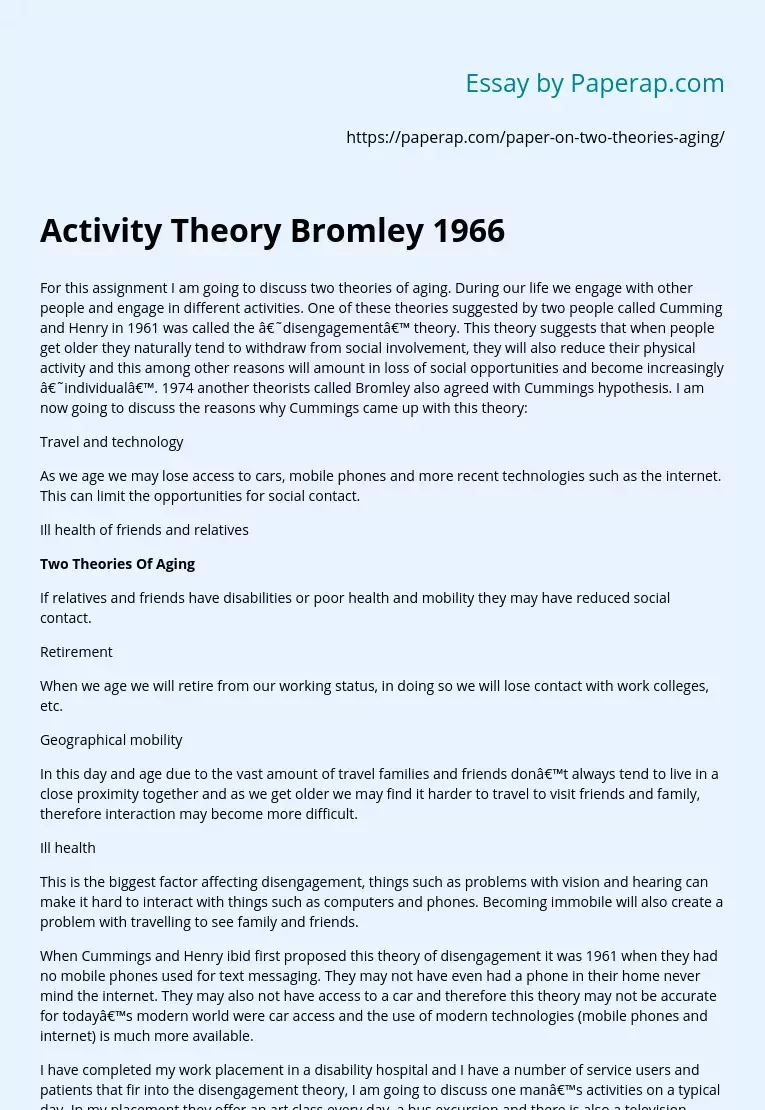Activity Theory Bromley 1966
For this assignment I am going to discuss two theories of aging. During our life we engage with other people and engage in different activities. One of these theories suggested by two people called Cumming and Henry in 1961 was called the ‘disengagement’ theory. This theory suggests that when people get older they naturally tend to withdraw from social involvement, they will also reduce their physical activity and this among other reasons will amount in loss of social opportunities and become increasingly ‘individual’.
1974 another theorists called Bromley also agreed with Cummings hypothesis. I am now going to discuss the reasons why Cummings came up with this theory:
Travel and technology
As we age we may lose access to cars, mobile phones and more recent technologies such as the internet. This can limit the opportunities for social contact.
Ill health of friends and relatives
Two Theories Of Aging
If relatives and friends have disabilities or poor health and mobility they may have reduced social contact.
Retirement
When we age we will retire from our working status, in doing so we will lose contact with work colleges, etc.
Geographical mobility
In this day and age due to the vast amount of travel families and friends don’t always tend to live in a close proximity together and as we get older we may find it harder to travel to visit friends and family, therefore interaction may become more difficult.
Ill health
This is the biggest factor affecting disengagement, things such as problems with vision and hearing can make it hard to interact with things such as computers and phones.
Becoming immobile will also create a problem with travelling to see family and friends.
When Cummings and Henry ibid first proposed this theory of disengagement it was 1961 when they had no mobile phones used for text messaging. They may not have even had a phone in their home never mind the internet. They may also not have access to a car and therefore this theory may not be accurate for today’s modern world were car access and the use of modern technologies (mobile phones and internet) is much more available.
I have completed my work placement in a disability hospital and I have a number of service users and patients that fir into the disengagement theory, I am going to discuss one man’s activities on a typical day. In my placement they offer an art class every day, a bus excursion and there is also a television room available. These facilities are available for all members of the hospital, however not all people take advantage of these opportunities as they prefer to disengage. One particular patient chooses to sit in his room by himself and listen to music rather than interact with other people. He does so as he feels he is getting old and this is the best method for him. Therefore, he fits into the disengagement theory.
In 1966 Bromley agreed that people need to ‘disengage’ as they get older but he also suggested they need to keep active to prevent disengaging from going too far that it turns into isolation and inaction. He argued it was important to stay mentally active and to maintain an interest in life and enjoy the company of friends and family. He said that too much disengagement would lead to the loss of mental capability and physical skills. This theory is known as an activity theory which argues that people need to stay active to reduce the risks associated with disengagement. I am now going to discuss ways in which we can stay active both physically and mentally:
How to stay physically active
Taking part in regular physical activity will improve your physical health in later life and we are advised to continue this in our elder years to maintain our physical health we can do this through a number of ways such as walking, yoga, gardening and swimming.
How to stay mentally active
Our brain is like a muscle and needs exercised regularly to keep it mentally active, some experts have suggested that having poor physical health can lead to loss in mental ability in later life. We can prevent this by doing some of the following challenging your brain everyday with things such as study, community activates such as book clubs, engage in regular discussion and crosswords and puzzles help to keep the brain active.
Health services, residential, day and home care will provide opportunities for physical, mental and social activities.
I have recently worked in a care home for the elderly and they provided a number of different activities for them to help keep them both mentally and physically active. The activities include some for the mind such as:
* Bingo
* Sudoku
* Reading
* Art
* Knitting
Then the physical side is:
* Yoga
* Swimming
* Walking
In the setting a number of people choose to take part in these activities and they want to stay fit and healthy for as long as possible. They fit into the active theory.
Overall I think it is best to stay active for as long as you can, it means a better social life and a healthier body and mind. It may even increase your life expectancy. I feel the disengagement theory would be very hard to do and feel it is very exclusive and lonely; however people will choose this lifestyle as it is their preferred choice, other people may be forced into disengagement theory for example the brain injured or disabled.
Activity Theory Bromley 1966. (2019, Dec 05). Retrieved from https://paperap.com/paper-on-two-theories-aging/

